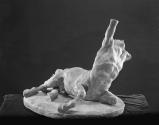Advanced Search
Dying Centaur
William Rimmer (American (born in England), 1816–1879)
1869
Object Place: New York, New York
Medium/Technique
Plaster
Dimensions
Overall: 55.9 × 61.6 × 64.8 cm (22 × 24 1/4 × 25 1/2 in.)
Credit Line
Bequest of Miss Caroline Hunt Rimmer
Accession NumberRES.19.127
NOT ON VIEW
CollectionsAmericas
ClassificationsSculpture
The powerful musculature and complex pose of the Dying Centaur reveal William Rimmer's unusual background as a physician and self-taught artist. The son of a cobbler who believed he was a lost descendant of French royalty, Rimmer grew up in Boston, where he displayed an early aptitude for art and dabbled in a variety of trades. While pursuing a painting career as a young man, he studied anatomy and soon began his own practice as a self-taught physician in Brockton and later in Milton, Massachusetts. His early and untutored experiments in sculpture caught the attention of Stephen H. Perkins, a wealthy Boston patron who came to champion Rimmer's career. Rimmer soon gained a measure of fame as a sculptor and art teacher noted for his understanding of human anatomy.
Dying Centaur depicts a familiar mythological subject without the classical restraint and calm of contemporary Neoclassical sculpture. Rimmer portrayed the sprawling figure in a moment of physical and spiritual anguish, one truncated arm extended heavenward as if imploring aid from the gods. The figure's raw emotion may reflect the influence of French artist Antoine-Louis Barye's romantic and violent animal sculptures, popular at this time. The work may also be an autobiographical statement about Rimmer's own melancholy, expressing his feelings of isolation and disappointment at the lack of adequate recognition during his lifetime. Immediately after his death, the Rimmer Memorial Committee selected Dying Centaur as the first of his compositions to be cast in bronze, and in 1880 the Museum of Fine Arts, Boston, held an important memorial exhibition of the artist's work.
This text was adapted from Ward, et al., MFA Highlights: American Decorative Arts & Sculpture (Boston, 2006) available at www.mfashop.com/mfa-publications.html.
Dying Centaur depicts a familiar mythological subject without the classical restraint and calm of contemporary Neoclassical sculpture. Rimmer portrayed the sprawling figure in a moment of physical and spiritual anguish, one truncated arm extended heavenward as if imploring aid from the gods. The figure's raw emotion may reflect the influence of French artist Antoine-Louis Barye's romantic and violent animal sculptures, popular at this time. The work may also be an autobiographical statement about Rimmer's own melancholy, expressing his feelings of isolation and disappointment at the lack of adequate recognition during his lifetime. Immediately after his death, the Rimmer Memorial Committee selected Dying Centaur as the first of his compositions to be cast in bronze, and in 1880 the Museum of Fine Arts, Boston, held an important memorial exhibition of the artist's work.
This text was adapted from Ward, et al., MFA Highlights: American Decorative Arts & Sculpture (Boston, 2006) available at www.mfashop.com/mfa-publications.html.
Inscriptions"W. Rimmer" on top of base, between the hooves
Provenance1879, by inheritance to Caroline Hunt Rimmer (b. 1851 - d. 1918) Belmont, Massachusetts (1); 1919, bequest of Rimmer to the MFA. (Accession date: July 17, 1919)
(1) lent to the MFA by Caroline Hunt Rimmer in 1893; removed and returned to Museum in 1905
(1) lent to the MFA by Caroline Hunt Rimmer in 1893; removed and returned to Museum in 1905



